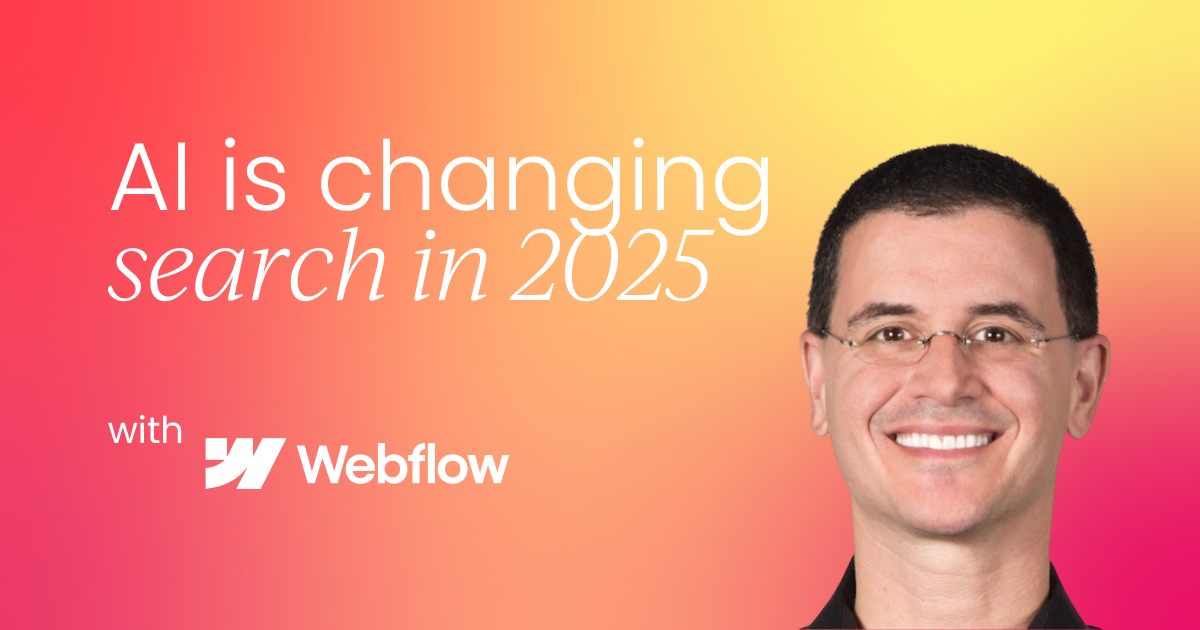Have you noticed something different about how you've been searching lately?
Perhaps you find yourself asking ChatGPT a series of questions instead of digging through dozens of Google results. Or maybe you find yourself getting instant answers from AI Overviews instead of ever clicking through to resources on the open web.
If so, you’re not alone.
User search behavior is undergoing a seismic shift. More queries than ever are ending without a single click to a website, and many people are turning to AI-powered assistants for instant (and increasingly comprehensive) answers. In fact, around 64% of Google searches in the US now end without the user clicking through to any external site.
It should go without saying that this is bad news for online publishers and businesses that have had success in building their pipelines on the back of organic traffic (looking at you, B2B SaaS providers).
What’s driving the shift?
There are a few factors behind these changes in search behavior.
Users want faster, more direct answers – and the tech is finally catching up to those expectations. LLMs are remarkable for their ability to deliver straightforward answers in a conversational tone, allowing users to bypass any interaction with human-generated resources.
Crucially, Google has taken notice. In mid-2023, it rolled out AI-generated summaries (the Search Generative Experience) at the top of search results for many queries. Early data from Google’s tests showed that these AI answers actually increased search engagement; CEO Sundar Pichai reported that users performed more searches, and were more satisfied, when AI summaries were present. (And if you don’t believe them, data from Kevin Indig points to something similar).
Note, though, that users are performing more searches. Not necessarily more clicks.
Research from Ahrefs goes as far as to suggest that the presence of an AI Overview can cause a 35% decrease in click-through for organic results.
Meanwhile, outside of Google’s ecosystem, the growth of ChatGPT (and similar tools like Claude and Perplexity) is itself a driver of change. ChatGPT became the fastest-growing app in history, and by early 2025, it was handling an estimated 37 million “search-like” queries per day.
Its rapid adoption tells us that consumers are eager for on-demand, personalized answers. Why scroll through a dozen links for a product recommendation or a how-to guide when an AI can synthesize it for you in seconds?
What comes next?
The reshaping of organic search is far from over. Google’s AI Mode – which is now available to all users in the US – is proof that the search giant is intent on doubling down on answer generation within its core product.

AI Mode represents a fundamental rethinking of how information is discovered and consumed online. Think of it as Google's effort to future-proof its status as the only search engine that matters – and that means winning market share back from ChatGPT.
How does Google's AI Mode actually work?
Once we accept that AI Mode is coming, our attention ought to shift to understanding how it works, and how it differs from traditional search.
It’s not an exaggeration to say that AI Mode represents a fundamental shift in how search engines process and expand user queries. At the heart of this transformation lies a technique called "query fan-out," which changes how content gets discovered, cited, and surfaced to users.
How does query fan-out work?
Query fan-out is Google's method of transforming a single user query into a constellation of related searches that happen invisibly in the background. When someone searches for "best CRM software for small business," Google's AI doesn't just look for content matching those exact words.
Instead, it generates dozens of synthetic queries across seven distinct categories, each designed to capture different aspects of user intent and semantic meaning.
According to Google's patent documentation, these synthetic query types include:
- Related Queries (semantically adjacent concepts)
- Implicit Queries (unstated user needs inferred through LLM reasoning)
- Comparative Queries (decision-making scenarios)
- Recent Query Context (conversational continuity)
- Personalized Queries (user-specific variations)
- Reformulation Queries (lexical alternatives)
- Entity-Expanded Queries (Knowledge Graph relationships)
For that "best CRM software for small business" search, Google might simultaneously explore queries like "CRM pricing comparison under $100/month," "Salesforce alternatives for startups," "CRM integration with email marketing tools," and "customer management software ROI for small teams."
Each synthetic query retrieves its own set of candidate documents, creating a rich corpus of information from which AI can synthesize comprehensive responses.
The process operates through what researchers call "dense retrieval" using vector embeddings (i.e. mathematical representations that understand meaning rather than just matching keywords), as opposed to sparse retrieval, which relies on exact word matches.
If you want to go even deeper on this topic, we recommend Michael King's deep dive into AI mode and Aleyda Solis' detailed look at the query fan technique itself.
What does AI Mode mean for marketers?
The introduction of AI Mode has several implications for marketers and businesses more broadly.
First, ranking becomes probabilistic rather than deterministic. Your content's visibility depends not just on traditional SEO factors, but semantic similarity scores, passage-level relevance, and alignment with AI reasoning chains.
Second, personalization becomes deeply embedded in the process. Through user embeddings, Google tailors query expansion and content selection based on individual search history, location, and behavioral patterns. The content strategies of the future will be based around hyper-targeted queries – and content that addresses precise user segments.
But most significantly, the unit of optimization has shifted from pages to passages. AI systems extract and cite individual paragraphs or sections that support specific reasoning steps, regardless of overall page authority.
A single sentence that effectively answers a synthetic query might be selected over an entire authoritative article that doesn't align with the AI's logical framework.
From SEO to relevance engineering: an evolution
The implications of these changes are far-reaching.
Traditional SEO approaches, focused on keyword density, topic clusters, and page-level optimization, will almost certainly need to evolve into something more like "relevance engineering"— i.e. the systematic optimization of content for AI consumption and citation.
Instead of targeting individual keywords, marketers should turn their attention to mapping out comprehensive semantic territories. Successful query expansion requires understanding not just the primary query, but the broader set of semantically-related queries that emerge from step-by-step reasoning processes.
This means keyword research should simulate the query fan-out process, identifying not just obvious related terms, but implicit user needs, comparative scenarios, and personalized variations.

Engineering content for AI citation
The transformation promised by AI Mode doesn't stop at content planning and strategy. Going forward, content will have to be restructured for AI consumption.
This means creating semantically complete passages that can stand alone when extracted by AI systems. Each section should answer specific questions directly, include relevant entities and data points, and be formatted for easy extraction.
In other words, every paragraph should be crafted to potentially serve as a citation in an AI-generated response. This means front-loading key information, using clear attribution for data points, and structuring content in scannable, modular formats that AI systems can easily extract and recombine.
This might take some getting used to. Properly structured pages in the AI era might feel like collections of standalone passages. The article you're currently reading certainly doesn't pass the test.
Hyper-targeted content will become the norm
Since AI Mode employs user embeddings to tailor responses based on individual search history, behavioral patterns, and contextual factors, the same query can produce dramatically different results for different users.
The upshot of this is that broad, generalized content will become increasingly ineffective, while precisely targeted content that aligns with specific user segments should gain a significant advantage in AI citation and visibility.
Businesses that understand this will pivot toward creating content variants that speak directly to distinct user personas and use cases. Rather than writing a single piece about "CRM implementation best practices", for example, successful content strategies now require creating separate resources for startup founders evaluating their first CRM, mid-market sales directors migrating from legacy systems, and enterprise IT teams managing complex integrations.
This approach also extends to creating content that anticipates the different stages of awareness and expertise within each segment. AI systems generating responses for beginners will prioritize educational, foundational content, while responses for experienced users will favor advanced implementation details and comparative analysis.
Your six-step action plan
The transition from traditional SEO to relevance engineering represents more than a tactical adjustment: it's a complete reimagining of how content creates value. If this feels overwhelming, we have an action plan any marketing leader can start implementing today.
- Start by auditing your current content through an AI lens. Review your highest-performing pages and ask: Could individual paragraphs stand alone as citations? Do your sections answer specific questions directly? Are you covering the semantic territory around your core topics, or just targeting exact-match keywords? Most existing content will need restructuring to succeed in AI-powered search environments.
- Restructure your keyword research methodology. Begin mapping comprehensive semantic territories around your core topics. For every primary keyword, identify the implicit user needs, comparative scenarios, personalized variations, and reasoning steps that AI systems might explore. This requires thinking beyond search volume data toward user intent analysis and reasoning chain mapping.
- Implement passage-level optimization. Every paragraph should be crafted as a potentially standalone citation. Front-load key information, include clear data attribution, and structure content in modular formats that AI systems can easily extract and recombine.
- Develop hyper-targeted content variants for different user segments. Create separate content variations that speak directly to distinct personas, use cases, and expertise levels within your target market. A single topic should spawn multiple resources, with each one optimized for different user contexts and semantic pathways.
- Build measurement capabilities for AI surfaces. Traditional SEO metrics become less meaningful in a zero-click world. Start tracking AI citation frequency, passage extraction patterns, and brand mention prominence in AI-generated responses.
- Invest in comprehensive content ecosystems. AI Mode's multimodal capabilities mean your content strategy must extend beyond text. Develop video explanations, podcast segments, interactive tools, and visual resources that can serve as source material for AI synthesis. Each format should be optimized for machine extraction while maintaining value for human consumption.
The age of AI-powered search has arrived. The question isn't whether these changes will impact your business. It's whether you'll be prepared when they do. The time to begin this transformation is now, while competitive advantages can still be built and market positions can still be secured.






.png)









 Follow us on LinkedIn
Follow us on LinkedIn




